spare wheel SAAB 9-5 2003 Owners Manual
[x] Cancel search | Manufacturer: SAAB, Model Year: 2003, Model line: 9-5, Model: SAAB 9-5 2003Pages: 288, PDF Size: 16.78 MB
Page 4 of 288
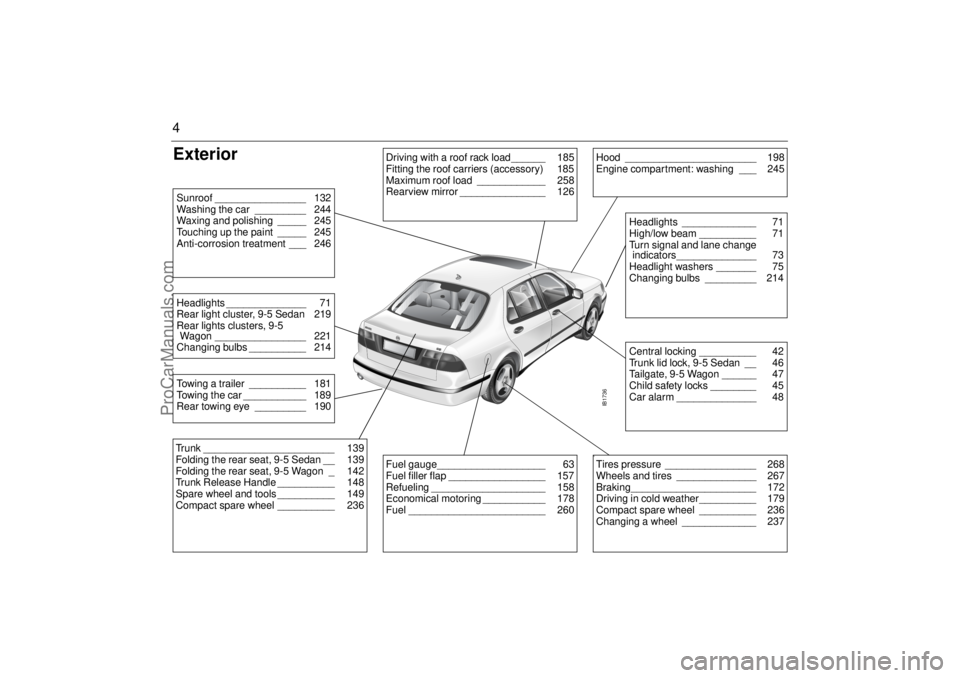
4Exterior
IB1736
Driving with a roof rack load______ 185
Fitting the roof carriers (accessory) 185
Maximum roof load ____________ 258
Rearview mirror _______________ 126
Hood _______________________ 198
Engine compartment: washing ___ 245
Central locking __________ 42
Trunk lid lock, 9-5 Sedan __ 46
Tailgate, 9-5 Wagon ______ 47
Child safety locks ________ 45
Car alarm ______________ 48Headlights _____________ 71
High/low beam __________ 71
Turn signal and lane change
indicators______________ 73
Headlight washers _______ 75
Changing bulbs _________ 214
Fuel gauge___________________ 63
Fuel filler flap _________________ 157
Refueling ____________________ 158
Economical motoring ___________ 178
Fuel ________________________ 260
b Tires pressure ________________ 268
Wheels and tires ______________ 267
Braking______________________ 172
Driving in cold weather__________ 179
Compact spare wheel __________ 236
Changing a wheel _____________ 237
Trunk _______________________ 139
Folding the rear seat, 9-5 Sedan __ 139
Folding the rear seat, 9-5 Wagon _ 142
Trunk Release Handle __________ 148
Spare wheel and tools __________ 149
Compact spare wheel __________ 236Towing a trailer __________ 181
Towing the car ___________ 189
Rear towing eye _________ 190Headlights ______________ 71
Rear light cluster, 9-5 Sedan 219
Rear lights clusters, 9-5
Wagon ________________ 221
Changing bulbs __________ 214Sunroof ________________ 132
Washing the car _________ 244
Waxing and polishing _____ 245
Touching up the paint _____ 245
Anti-corrosion treatment ___ 246
ProCarManuals.com
Page 9 of 288
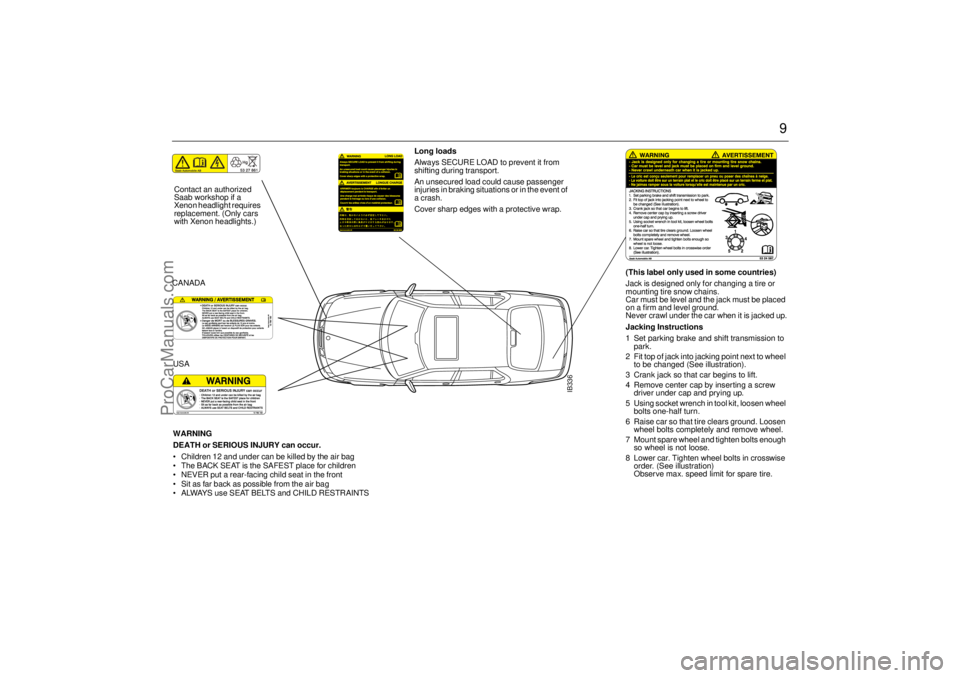
9
IB336
(This label only used in some countries)
Jack is designed only for changing a tire or
mounting tire snow chains.
Car must be level and the jack must be placed
on a firm and level ground.
Never crawl under the car when it is jacked up.
Jacking Instructions
1 Set parking brake and shift transmission to
park.
2 Fit top of jack into jacking point next to wheel
to be changed (See illustration).
3 Crank jack so that car begins to lift.
4 Remove center cap by inserting a screw
driver under cap and prying up.
5 Using socket wrench in tool kit, loosen wheel
bolts one-half turn.
6 Raise car so that tire clears ground. Loosen
wheel bolts completely and remove wheel.
7 Mount spare wheel and tighten bolts enough
so wheel is not loose.
8 Lower car. Tighten wheel bolts in crosswise
order. (See illustration)
Observe max. speed limit for spare tire.
CANADAUSA
WARNING
DEATH or SERIOUS INJURY can occur.
Children 12 and under can be killed by the air bag
The BACK SEAT is the SAFEST place for children
NEVER put a rear-facing child seat in the front
Sit as far back as possible from the air bag
ALWAYS use SEAT BELTS and CHILD RESTRAINTSContact an authorized
Saab workshop if a
Xenon headlight requires
replacement. (Only cars
with Xenon headlights.)
Long loads
Always SECURE LOAD to prevent it from
shifting during transport.
An unsecured load could cause passenger
injuries in braking situations or in the event of
a crash.
Cover sharp edges with a protective wrap.
ProCarManuals.com
Page 123 of 288
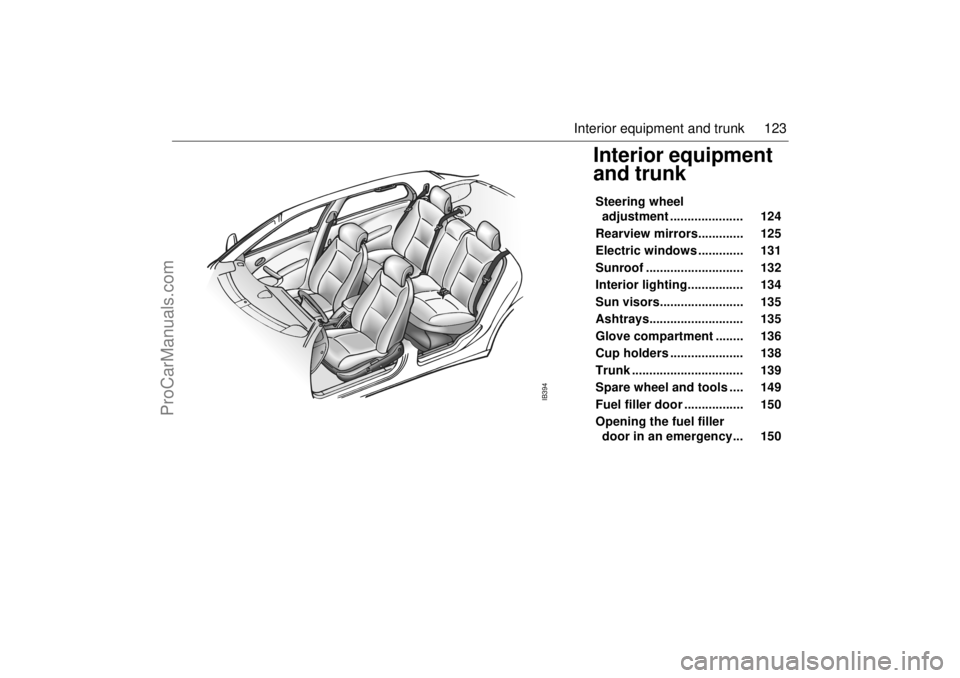
123 Interior equipment and trunk
Interior equipment
and trunk Steering wheel
adjustment ..................... 124
Rearview mirrors............. 125
Electric windows ............. 131
Sunroof ............................ 132
Interior lighting................ 134
Sun visors........................ 135
Ashtrays........................... 135
Glove compartment ........ 136
Cup holders ..................... 138
Trunk ................................ 139
Spare wheel and tools .... 149
Fuel filler door ................. 150
Opening the fuel filler
door in an emergency... 150
IB394
ProCarManuals.com
Page 149 of 288
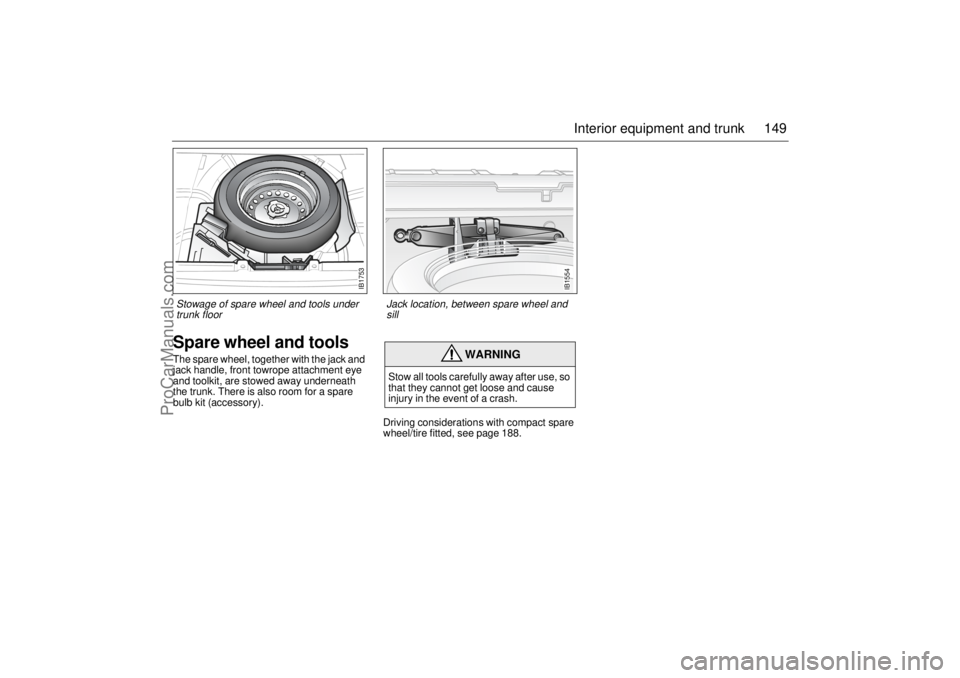
149 Interior equipment and trunk
Spare wheel and toolsThe spare wheel, together with the jack and
jack handle, front towrope attachment eye
and toolkit, are stowed away underneath
the trunk. There is also room for a spare
bulb kit (accessory).
Driving considerations with compact spare
wheel/tire fitted, see page 188.
WARNING
Stow all tools carefully away after use, so
that they cannot get loose and cause
injury in the event of a crash.
IB1753
Stowage of spare wheel and tools under
trunk floor
IB1554
Jack location, between spare wheel and
sill
ProCarManuals.com
Page 151 of 288
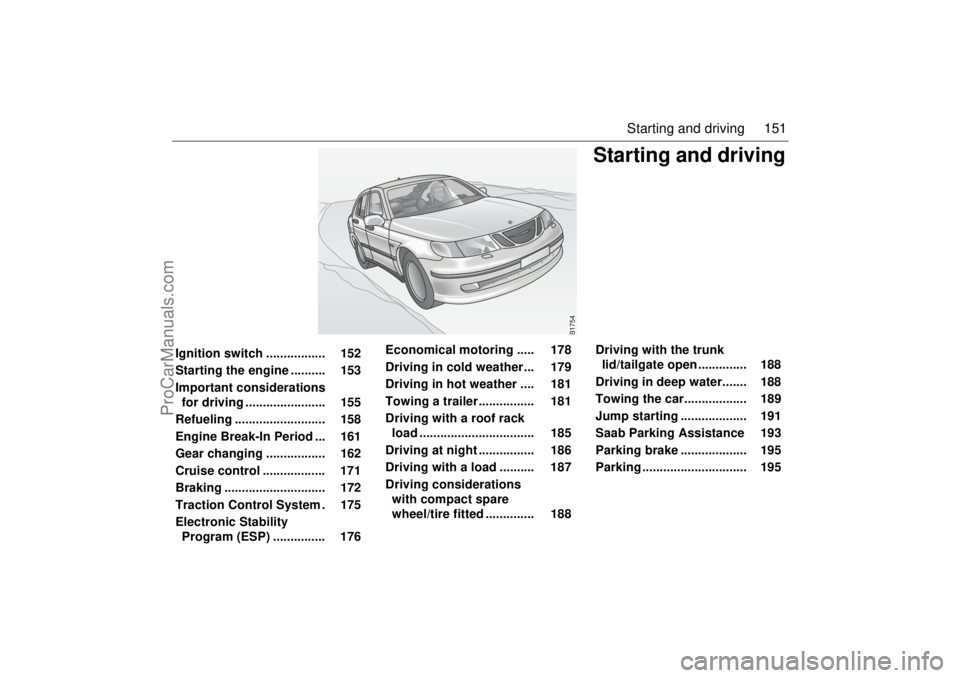
151 Starting and driving
Starting and driving
B1754
Ignition switch ................. 152
Starting the engine .......... 153
Important considerations
for driving ....................... 155
Refueling .......................... 158
Engine Break-In Period ... 161
Gear changing ................. 162
Cruise control .................. 171
Braking ............................. 172
Traction Control System . 175
Electronic Stability
Program (ESP) ............... 176 Economical motoring ..... 178
Driving in cold weather... 179
Driving in hot weather .... 181
Towing a trailer ................ 181
Driving with a roof rack
load ................................. 185
Driving at night ................ 186
Driving with a load .......... 187
Driving considerations
with compact spare
wheel/tire fitted .............. 188 Driving with the trunk
lid/tailgate open .............. 188
Driving in deep water....... 188
Towing the car.................. 189
Jump starting ................... 191
Saab Parking Assistance 193
Parking brake ................... 195
Parking .............................. 195
ProCarManuals.com
Page 167 of 288

167 Starting and driving
Descending hillsIf the speed of the car increases while
descending a steep hill, despite the acceler-
ator being released, the control module will
change down a gear when you brake. If you
desire more powerful engine braking, man-
ually select a lower gear.
Sentronic, manual modeMove the selector lever to the M position.
Select a higher gear by flicking the
right-hand paddle towards you. Select
a lower gear by flicking the left-hand paddle
towards you.
An example of when you may wish to make
manual gear changes is when overtaking, to
enable you to remain in a low gear for an
extended period of time.
Changes from 3rd to 4th and from 4th to 5th
can be made when the engine speed is
above roughly 2,000 rpm.
If the road surface is slippery, you may wish
to pull off in 2nd or 3rd to reduce the risk of
wheel spin.
When descending hills you should select a
low gear to increase the braking effect of the
engine and thus spare the brakes.
Manual gear selections are shown on the
main instrument panel. The selector posi-
tion and the current gear are displayed.When the selector lever is in the M position,
as opposed to the D position, gas engines
are much more responsive to changes in
accelerator position. The accelerator has a
different feel.
When in manual mode, kick-down operates
for 4th and 5th gears (below 2,000 rpm).
Kick-down cannot be activated in 1st, 2nd or
3rd gears.
For optimum performance, gear changes
should be made before reaching 6,000 rpm.
To avoid damaging the engine and trans-
mission, the transmission will shift up a gear
if the engine is in danger of overrevving. You
may feel a slight jolt before this gear change
is effected.
Paddles on the steering wheel for
changing gear manually
ProCarManuals.com
Page 188 of 288
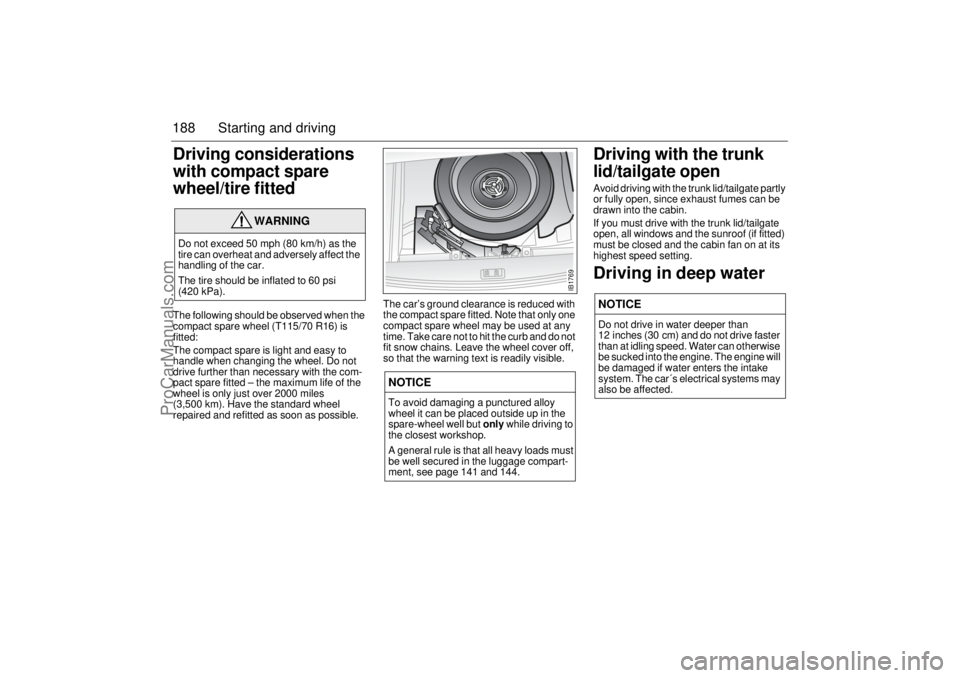
188 Starting and drivingDriving considerations
with compact spare
wheel/tire fittedThe following should be observed when the
compact spare wheel (T115/70 R16) is
fitted:
The compact spare is light and easy to
handle when changing the wheel. Do not
drive further than necessary with the com-
pact spare fitted – the maximum life of the
wheel is only just over 2000 miles
(3,500 km). Have the standard wheel
repaired and refitted as soon as possible. The car’s ground clearance is reduced with
the compact spare fitted. Note that only one
compact spare wheel may be used at any
time. Take care not to hit the curb and do not
fit snow chains. Leave the wheel cover off,
so that the warning text is readily visible.
Driving with the trunk
lid/tailgate openAvoid driving with the trunk lid/tailgate partly
or fully open, since exhaust fumes can be
drawn into the cabin.
If you must drive with the trunk lid/tailgate
open, all windows and the sunroof (if fitted)
must be closed and the cabin fan on at its
highest speed setting.Driving in deep water
WARNING
Do not exceed 50 mph (80 km/h) as the
tire can overheat and adversely affect the
handling of the car.
The tire should be inflated to 60 psi
(420 kPa).
NOTICETo avoid damaging a punctured alloy
wheel it can be placed outside up in the
spare-wheel well but only while driving to
the closest workshop.
A general rule is that all heavy loads must
be well secured in the luggage compart-
ment, see page 141 and 144.
NOTICEDo not drive in water deeper than
12 inches (30 cm) and do not drive faster
than at idling speed. Water can otherwise
be sucked into the engine. The engine will
be damaged if water enters the intake
system. The car´s electrical systems may
also be affected.
IB1769
ProCarManuals.com
Page 189 of 288
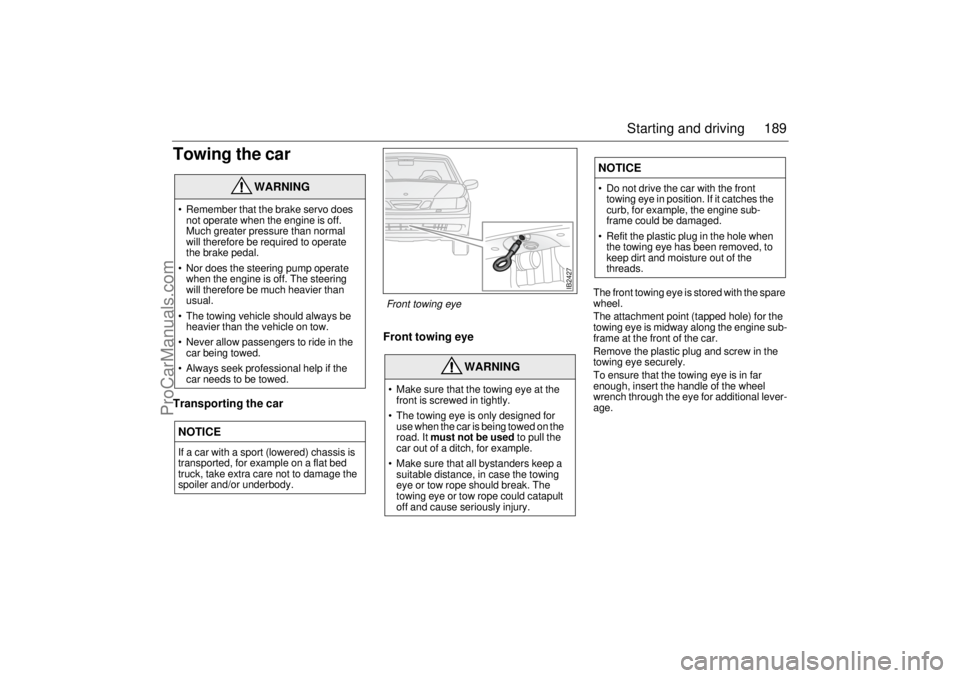
189 Starting and driving
Towing the carTransporting the car Front towing eye
The front towing eye is stored with the spare
wheel.
The attachment point (tapped hole) for the
towing eye is midway along the engine sub-
frame at the front of the car.
Remove the plastic plug and screw in the
towing eye securely.
To ensure that the towing eye is in far
enough, insert the handle of the wheel
wrench through the eye for additional lever-
age.
WARNING
Remember that the brake servo does
not operate when the engine is off.
Much greater pressure than normal
will therefore be required to operate
the brake pedal.
Nor does the steering pump operate
when the engine is off. The steering
will therefore be much heavier than
usual.
The towing vehicle should always be
heavier than the vehicle on tow.
Never allow passengers to ride in the
car being towed.
Always seek professional help if the
car needs to be towed.NOTICEIf a car with a sport (lowered) chassis is
transported, for example on a flat bed
truck, take extra care not to damage the
spoiler and/or underbody.
WARNING
Make sure that the towing eye at the
front is screwed in tightly.
The towing eye is only designed for
use when the car is being towed on the
road. It must not be used to pull the
car out of a ditch, for example.
Make sure that all bystanders keep a
suitable distance, in case the towing
eye or tow rope should break. The
towing eye or tow rope could catapult
off and cause seriously injury.
NOTICE Do not drive the car with the front
towing eye in position. If it catches the
curb, for example, the engine sub-
frame could be damaged.
Refit the plastic plug in the hole when
the towing eye has been removed, to
keep dirt and moisture out of the
threads.
IB2427
Front towing eye
ProCarManuals.com
Page 197 of 288
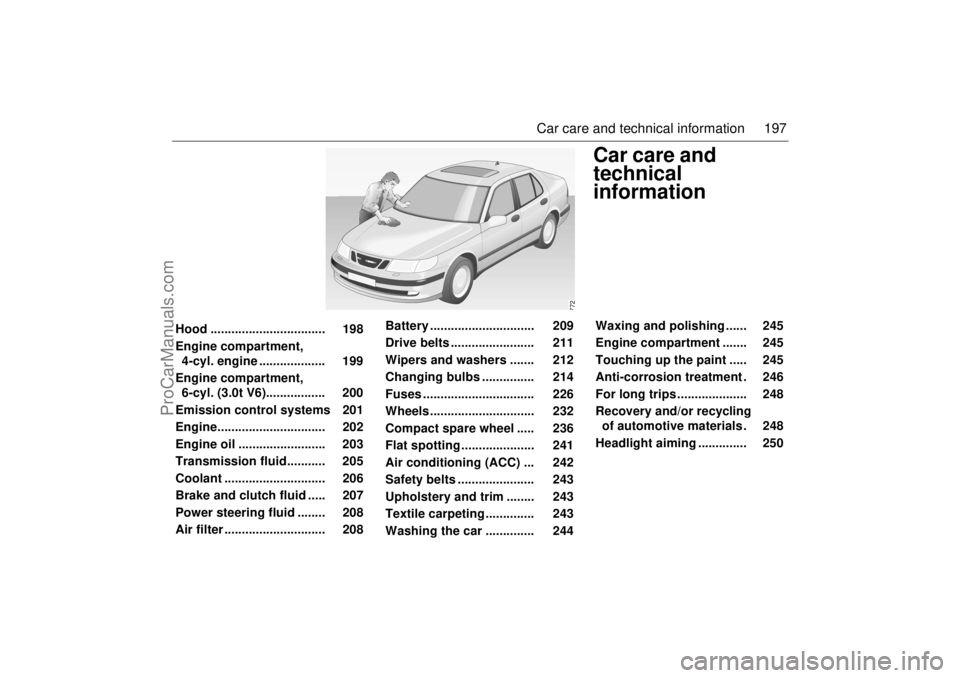
197 Car care and technical information
Car care and
technical
information
772
Hood ................................. 198
Engine compartment,
4-cyl. engine ................... 199
Engine compartment,
6-cyl. (3.0t V6)................. 200
Emission control systems 201
Engine............................... 202
Engine oil ......................... 203
Transmission fluid........... 205
Coolant ............................. 206
Brake and clutch fluid ..... 207
Power steering fluid ........ 208
Air filter ............................. 208 Battery .............................. 209
Drive belts ........................ 211
Wipers and washers ....... 212
Changing bulbs ............... 214
Fuses ................................ 226
Wheels .............................. 232
Compact spare wheel ..... 236
Flat spotting..................... 241
Air conditioning (ACC) ... 242
Safety belts ...................... 243
Upholstery and trim ........ 243
Textile carpeting.............. 243
Washing the car .............. 244 Waxing and polishing ...... 245
Engine compartment ....... 245
Touching up the paint ..... 245
Anti-corrosion treatment . 246
For long trips .................... 248
Recovery and/or recycling
of automotive materials. 248
Headlight aiming .............. 250
ProCarManuals.com
Page 207 of 288
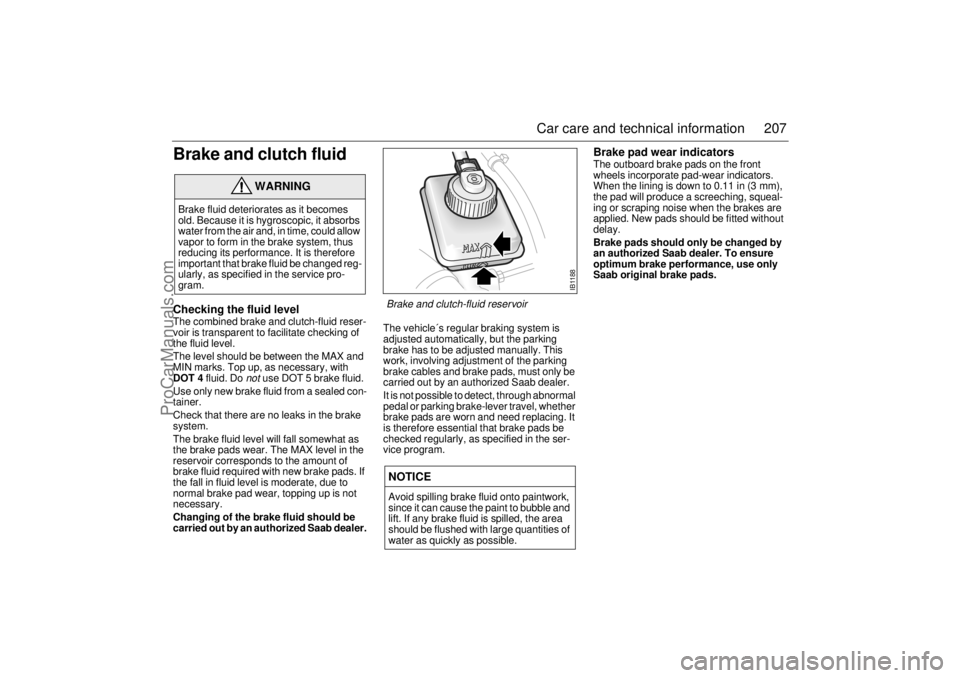
207 Car care and technical information
Brake and clutch fluid Checking the fluid level The combined brake and clutch-fluid reser-
voir is transparent to facilitate checking of
the fluid level.
The level should be between the MAX and
MIN marks. Top up, as necessary, with
DOT 4 fluid. Do
not
use DOT 5 brake fluid.
Use only new brake fluid from a sealed con-
tainer.
Check that there are no leaks in the brake
system.
The brake fluid level will fall somewhat as
the brake pads wear. The MAX level in the
reservoir corresponds to the amount of
brake fluid required with new brake pads. If
the fall in fluid level is moderate, due to
normal brake pad wear, topping up is not
necessary.
Changing of the brake fluid should be
carried out by an authorized Saab dealer.The vehicle´s regular braking system is
adjusted automatically, but the parking
brake has to be adjusted manually. This
work, involving adjustment of the parking
brake cables and brake pads, must only be
carried out by an authorized Saab dealer.
It is not possible to detect, through abnormal
pedal or parking brake-lever travel, whether
brake pads are worn and need replacing. It
is therefore essential that brake pads be
checked regularly, as specified in the ser-
vice program.
Brake pad wear indicators The outboard brake pads on the front
wheels incorporate pad-wear indicators.
When the lining is down to 0.11 in (3 mm),
the pad will produce a screeching, squeal-
ing or scraping noise when the brakes are
applied. New pads should be fitted without
delay.
Brake pads should only be changed by
an authorized Saab dealer. To ensure
optimum brake performance, use only
Saab original brake pads.
WARNING
Brake fluid deteriorates as it becomes
old. Because it is hygroscopic, it absorbs
water from the air and, in time, could allow
vapor to form in the brake system, thus
reducing its performance. It is therefore
important that brake fluid be changed reg-
ularly, as specified in the service pro-
gram.
NOTICEAvoid spilling brake fluid onto paintwork,
since it can cause the paint to bubble and
lift. If any brake fluid is spilled, the area
should be flushed with large quantities of
water as quickly as possible.
IB1188
Brake and clutch-fluid reservoir
ProCarManuals.com